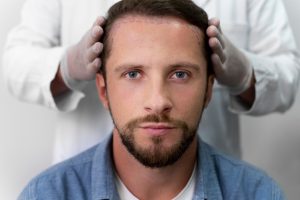
Noticing more hair falling out than usual? Hair loss expert Dr. Omar shares five causes of hair loss and a reliable solution.
For many of us, hair is a major part of our identity. It gives us character, confidence, and personality. But did you know that about 8 million women in the UK experience some degree of hair loss or thinning? If you’re dealing with hair thinning or hair loss and haven’t talked about it, you’re not alone. Nearly 46% of women with hair loss suffer in silence due to insecurity or embarrassment.
Losing hair is actually a normal part of life. On average, we lose between 100 to 150 strands of hair daily. What most people don’t realize is that hair follicles go through three stages in the Hair Growth Cycle, and one of these involves shedding hair.
A common myth is that hair loss isn’t treatable. But while many supplements and vitamins claim to help, not all are proven to be effective. If you’re concerned that your hair loss isn’t normal, there are some solutions that work. First, though, you need to understand the hair growth cycle and the causes of hair loss.
The hair growth cycle consists of three stages:
1. Growth Phase (Anagen Phase): About 85 to 90% of our hair is growing at any given time, and this phase lasts for three to five years.
2. Transition Phase (Catagen Phase): Hair stops growing and disconnects from the follicle. Only about 1% of hair is in this phase, which lasts one to two weeks.
3. Resting Phase (Telogen Phase): Around 10 to 15% of hair is in this phase, where it’s inactive for three to four months before shedding.
When you shed more hair than usual and it doesn’t grow back, that’s when there’s a problem. Hair loss can appear suddenly or over time and can affect different areas of your scalp. Signs of hair loss, often called alopecia, stem from a disrupted Hair Growth Cycle. This leads to more hair in the resting phase and less in the growth phase, causing increased shedding and weaker regrowth.
There are many potential triggers for hair loss, making it hard to identify the exact cause. Here are five common causes:
1. Genetics (Hereditary Hair Loss): The most common type, known as male-pattern or female-pattern hair loss, is usually genetic. This kind of hair loss is gradual and leads to thinning hair, receding hairlines in men, and thinner hair overall.
Treatment focuses on rebalancing the Hair Growth Cycle, often using supplements containing Proteoglycans. These are crucial biological molecules that help regulate hair growth.
2. Hormonal Imbalance: Hormones like dihydrotestosterone (DHT) can cause hair loss. Both men and women produce testosterone, which can convert to DHT and shrink hair follicles, especially problematic during menopause or for those with conditions like PCOS.
3. Stress: High levels of stress can lead to inflammation and elevated cortisol, the body’s stress hormone, which affects hair growth. Stress-related hair loss usually shows up a few months after a stressful event but can reverse if stress levels are managed.
4. Medications: Some drugs, including those for cancer, high blood pressure, and depression, can cause hair loss. This is usually temporary and stops once the medication is adjusted or discontinued.
5. Pregnancy: While pregnancy hormones often make hair thicker, some women experience thinning due to hormonal changes. Postpartum hair loss is also common, usually resolved as hormone levels normalize.
If you notice excessive hair shedding, consult a doctor. Treatments like Proteoglycan Replacement Therapy, using products like Nourkrin, can help re-balance the Hair Growth Cycle by supplying essential nutrients.
In clinical studies, women on Nourkrin reported significant improvements in hair growth and quality after six months. If you think hormonal imbalance or stress is affecting your hair, managing these can also help your hair return to its normal growth cycle. For persistent issues, seek medical advice to identify the most effective treatment plan.




